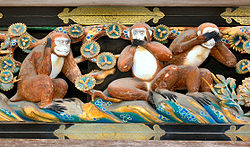
Toshogu
Encyclopedia

Tokugawa Ieyasu
was the founder and first shogun of the Tokugawa shogunate of Japan , which ruled from the Battle of Sekigahara in 1600 until the Meiji Restoration in 1868. Ieyasu seized power in 1600, received appointment as shogun in 1603, abdicated from office in 1605, but...
is enshrined with the name Tōshō Daigongen (東照大権現). Ieyasu was the founder of the Tokugawa shogunate
Tokugawa shogunate
The Tokugawa shogunate, also known as the and the , was a feudal regime of Japan established by Tokugawa Ieyasu and ruled by the shoguns of the Tokugawa family. This period is known as the Edo period and gets its name from the capital city, Edo, which is now called Tokyo, after the name was...
(1603-1868), which is the third and last of the shogunal governments in Japanese history. It is part of Shrines and Temples of Nikkō
Shrines and Temples of Nikkō
The UNESCO World Heritage Site Shrines and Temples of Nikkō encompasses 103 buildings or structures and the natural setting around them. It is located in Nikkō, Tochigi Prefecture, Japan. The buildings belong to two Shinto shrines and one Buddhist temple...
UNESCO World Heritage site.
Tōshō-gū shrines are found throughout Japan. The most famous Tōshō-gū
Nikko Tosho-gu
is a Shinto shrine located in Nikkō, Tochigi Prefecture, Japan. It is part of the "Shrines and Temples of Nikkō", a UNESCO World Heritage Site.Tōshō-gū is dedicated to Tokugawa Ieyasu, the founder of the Tokugawa shogunate. Initially built in 1617, during the Edo period, while Ieyasu's son Hidetada...
is located in Nikkō
Nikko, Tochigi
is a city in the mountains of Tochigi Prefecture, Japan. Approximately 140 km north of Tokyo and 35 km west of Utsunomiya, the capital of Tochigi Prefecture, it is a popular destination for Japanese and international tourists...
in Tochigi Prefecture
Tochigi Prefecture
is a prefecture located in the Kantō region on the island of Honshū, Japan. The capital is the city of Utsunomiya.Nikkō, whose ancient Shintō shrines and Buddhist temples UNESCO has recognized by naming them a World Heritage Site, is in this prefecture...
. It is one of Japan's most popular destinations for tourists.
Ieyasu's son, the second shogun Hidetada
Tokugawa Hidetada
was the second shogun of the Tokugawa dynasty, who ruled from 1605 until his abdication in 1623. He was the third son of Tokugawa Ieyasu, the first shogun of the Tokugawa shogunate.-Early life :...
, ordered the construction of the Nikkō Tōshō-gū. Later, the third shogun Iemitsu
Tokugawa Iemitsu
Tokugawa Iemitsu was the third shogun of the Tokugawa dynasty. He was the eldest son of Tokugawa Hidetada, and the grandson of Tokugawa Ieyasu. Iemitsu ruled from 1623 to 1651.-Early life :...
had the shrine greatly enlarged and lavishly decorated.

Ueno Park
is a spacious public park located in the Ueno section of Taitō, Tokyo, Japan. It occupies the site of the former Kan'ei-ji, a temple closely associated with the Tokugawa shoguns, who had built the temple to guard Edo Castle against the north-east, then considered an unlucky direction...
in Tokyo is also widely known. Another, at Kunōzan
Kunozan Tosho-gu
The is a Shintō shrine in Suruga-ku in the city of Shizuoka in Shizuoka Prefecture, Japan. It is the original burial place of the first Shōgun of the Tokugawa Shogunate, Tokugawa Ieyasu, and is thus the oldest of the Tōshō-gū shrines in the country. The main festival of the shrine is held annually...
in Shizuoka prefecture
Shizuoka Prefecture
is a prefecture of Japan located in the Chūbu region on Honshu island. The capital is the city of Shizuoka.- History :Shizuoka prefecture was formed from the former Tōtōmi, Suruga and Izu provinces.The area was the home of the first Tokugawa Shogun...
, rivals Nikkō's for decorative splendor. A Tōshō-gū can also be found at Miyanochō, in Sendai.
During the Edo period
Edo period
The , or , is a division of Japanese history which was ruled by the shoguns of the Tokugawa family, running from 1603 to 1868. The political entity of this period was the Tokugawa shogunate....
, these shrines reached 500 in number. After the Meiji Restoration
Meiji Restoration
The , also known as the Meiji Ishin, Revolution, Reform or Renewal, was a chain of events that restored imperial rule to Japan in 1868...
, many were abandoned, and others united with shrines in the area. Presently, there are about 130 Tōshō-gū.
See also
- Tourism in JapanTourism in JapanTourism in Japan attracted 8.3 million foreign visitors in 2008, slightly more than Singapore and Ireland. Japan has 16 World Heritage Sites, including Himeji Castle and Historic Monuments of Ancient Kyoto . Kyoto receives over 30 million tourists annually...
- List of World Heritage Sites in Japan
External links
- Toshogu.net (in Japanese)
- National Archives of Japan: Illustrations of Road to Nikko, Tempo 14 (1843)

